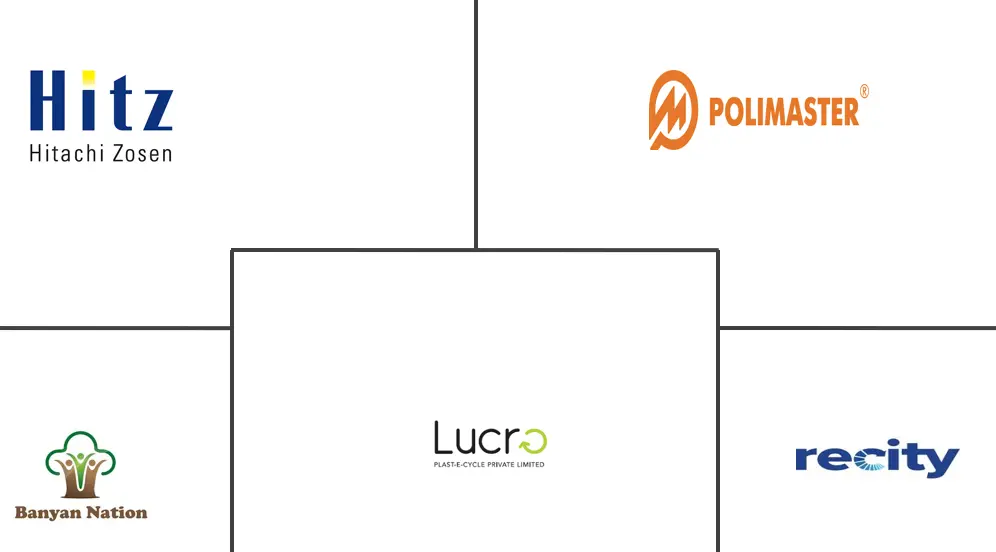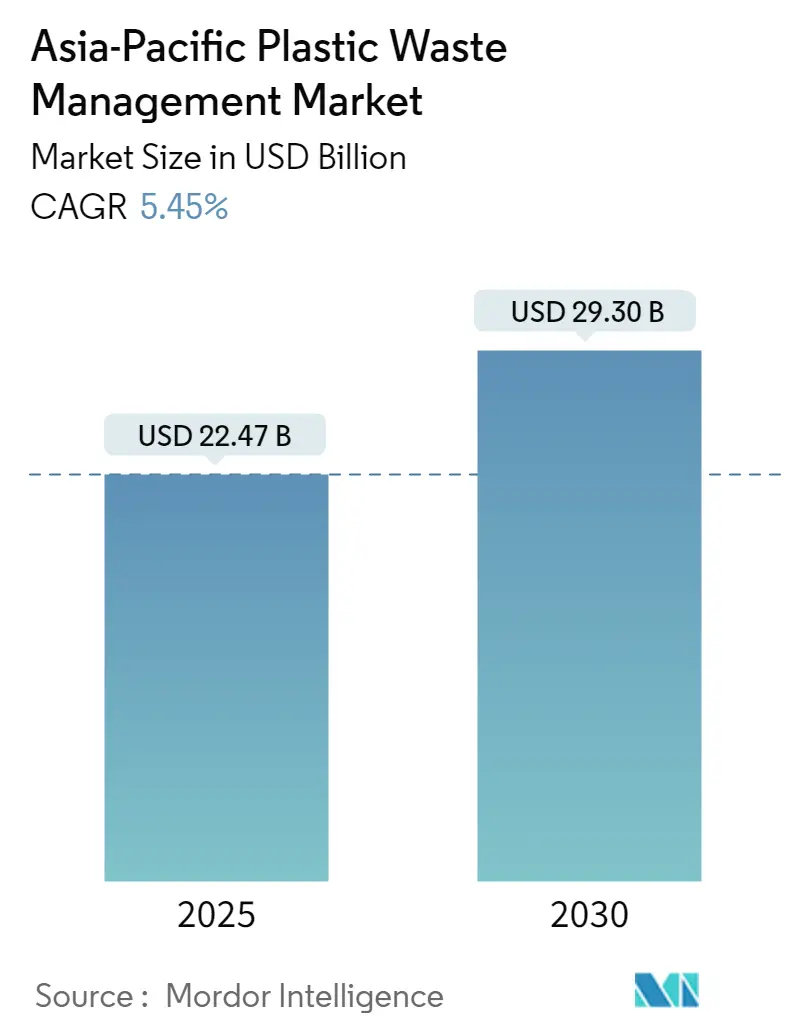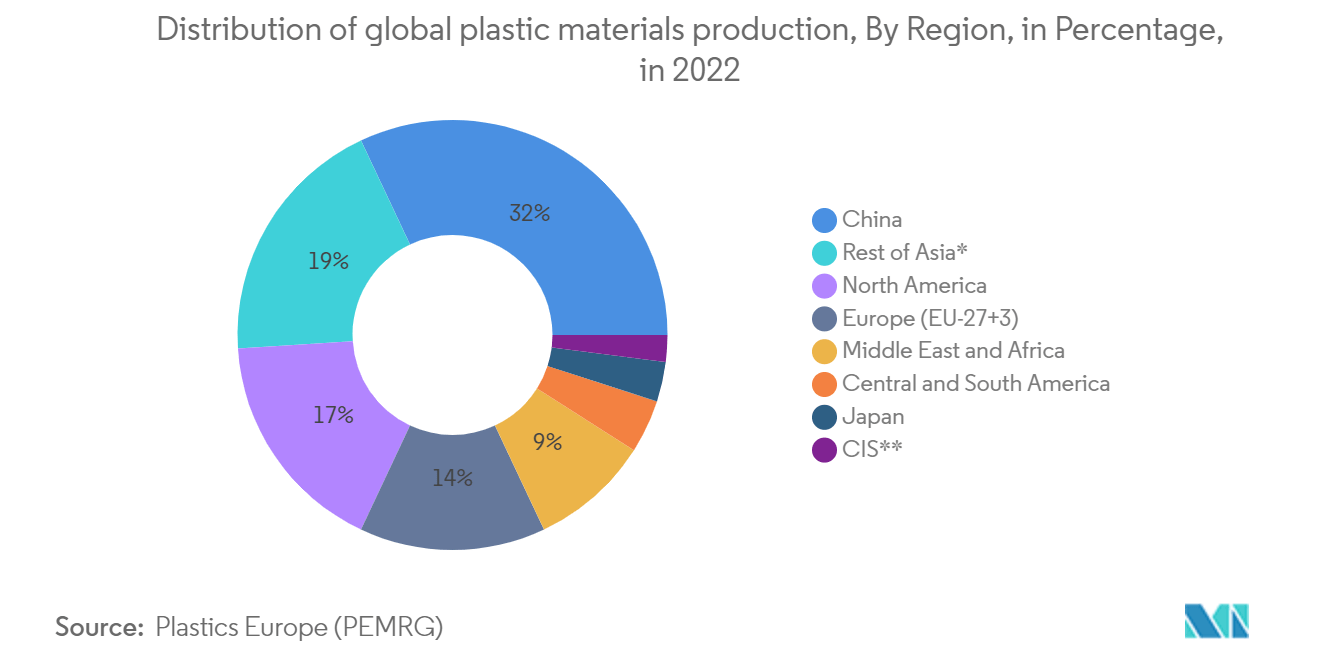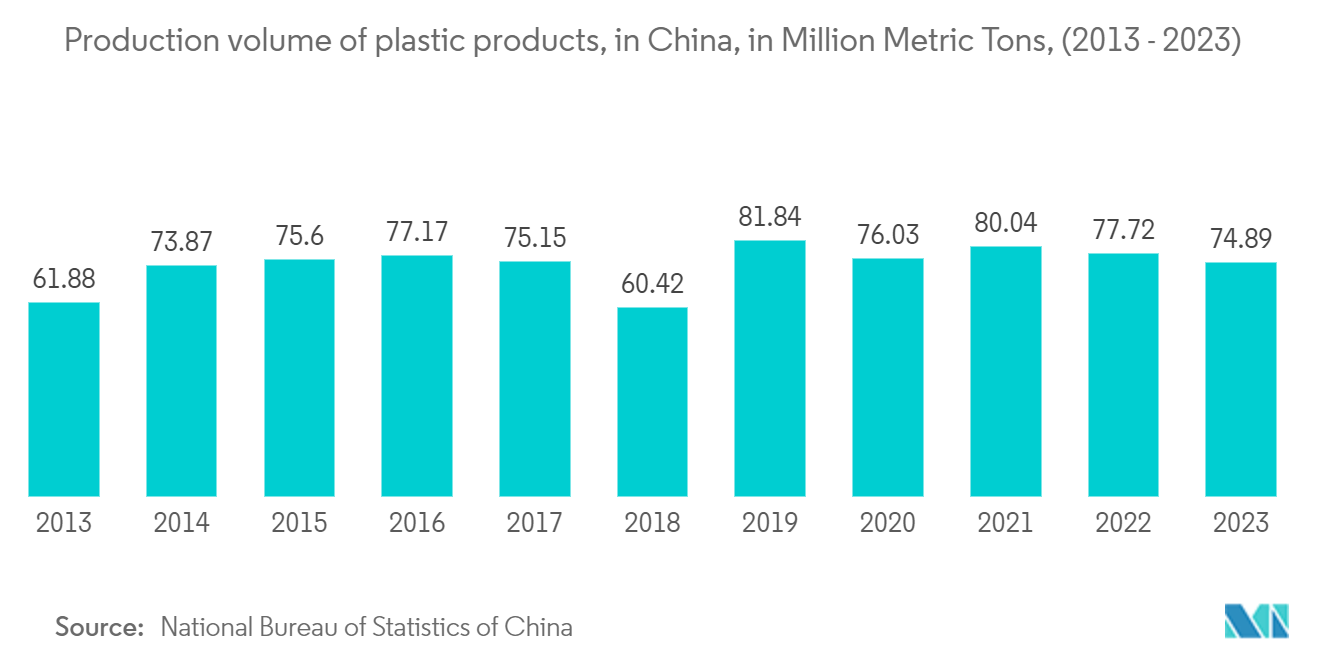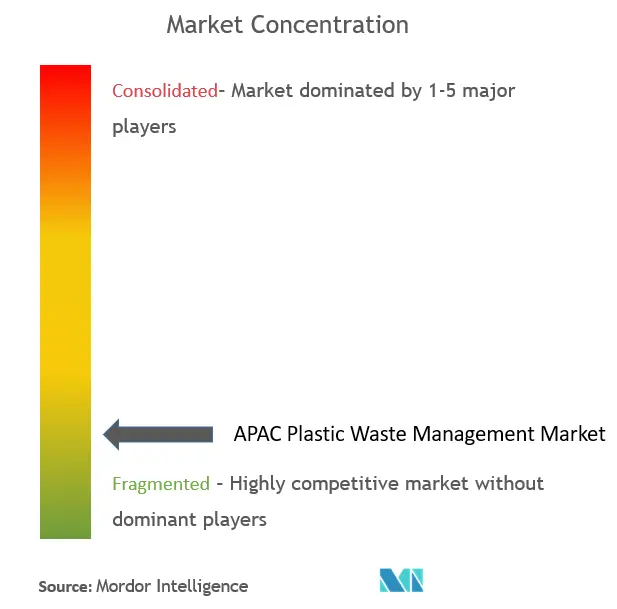Asia-Pacific Plastic Waste Management Market Analysis
The Asia-Pacific Plastic Waste Management Market size is estimated at USD 22.47 billion in 2025, and is expected to reach USD 29.30 billion by 2030, at a CAGR of 5.45% during the forecast period (2025-2030).
Rapid urbanization and industrial expansion in Asia-Pacific are fueling a surge in plastic consumption and waste production. Notably, urban centers in countries like China and India stand out as primary plastic waste generators. Governments in the APAC region are responding with increasingly stringent measures. These include bans on single-use plastics, the introduction of extended producer responsibility (EPR) programs, and incentives to promote recycling. For instance, China has enforced a ban on plastic waste imports, while India has rolled out its own set of plastic waste management regulations.
Technological advancements in recycling, spanning from sophisticated sorting systems to chemical and biodegradable recycling methods, are reshaping the plastic waste management landscape. Simultaneously, there is a rising trend in adopting digital waste tracking and management solutions. As public awareness of environmental issues surrounding plastic pollution grows, consumers demand more sustainable products and responsible waste management. This, in turn, pushes companies toward eco-friendly practices and substantial investments in recycling infrastructure.
The economic potential of the plastic waste management market in Asia-Pacific is vast, especially in areas like collection, sorting, recycling, and waste-to-energy technologies. As a result, investments in recycling infrastructure and waste management facilities are rising. However, challenges persist, including inadequate waste management infrastructure in several APAC nations, low recycling rates, and the prevalence of mixed and contaminated plastic waste. Addressing these challenges will require infrastructure upgrades and heightened public awareness and engagement in waste segregation.
Asia-Pacific Plastic Waste Management Market Trends
Rapid Urbanization Exacerbates Escalating Plastic Predicament in Asia-Pacific
With a population of approximately 4 billion, Asia-Pacific (APAC) is witnessing rapid urbanization, exacerbating its escalating plastic predicament. A UN report highlights that APAC already hosts 28 megacities, and an estimated 120,000 individuals are relocating to urban centers in the region daily. Projections suggest that a staggering 3.3 billion people will live in cities in Asia-Pacific by the year 2050. This surge in urbanization has fueled consumption, notably spiking the demand for single-use packaging, especially in the flexible plastic segment. If the current trajectory persists, APAC is set to generate a colossal 140 million tonnes of plastic waste by 2030.
Given that many of the world's most populous countries reside in the APAC region, the surge in urbanization is accompanied by shifting lifestyles and heightened appetites for packaged goods. Flexibility in packaging emerges as a focal concern in APAC. The region's allure for production, especially in the food sector, is bolstered by its lower associated costs. In 2023, APAC commanded a 52.2% share in the flexible packaging market. Noteworthy players like Uflex and Fuji Seal International fortify the industry's standing in the region. APAC's penchant for single-use plastic packaging, notably in pouches and sachets (e.g., single-serve water packages in India), is largely due to the cost advantage these materials offer.
The case of single-use plastic bags in Indonesia vividly illustrates the efficacy of APAC regulations. Following a successful trial in 23 cities and municipalities, Jakarta enforced a blanket ban on plastic bags in July 2020. Despite initial pushback from businesses, the regulation was upheld, with non-compliant companies facing fines and repeat offenders risking permit revocation.
The reported results indicate the ban's success. In 2018, Jakarta consumed an estimated 240-300 million plastic bags annually. By 2021, this consumption had dropped by 42%, from 11,192 tons to 6,452 tons.
On a global scale, Bangladesh led the way by implementing a national plastic bag ban in 2002. China initiated its ban in 2020, with the final phase set for 2025. India also joined the movement, implementing a ban on single-use plastics in 2022.
Despite these advancements, parts of the Asia-Pacific (APAC) region are struggling to keep pace. South Korea consumes a staggering 19 billion plastic bags each year, as reported by the Korea Zero Waste Movement Network. Meanwhile, Thailand's government survey revealed an annual consumption of around 200 billion plastic bags, translating to an average of eight bags per citizen per day. The Ocean Conservancy highlights Thailand as the sixth-largest contributor to global marine waste.
The conclusion is that despite notable progress in plastic regulation across various APAC nations, the region still needs to overcome significant plastic consumption and waste management challenges. Stringent enforcement and innovative solutions are imperative to address this, especially given the region's rapid urbanization.
China is Making Strides in Waste Management
In 2023, China's initiative, spearheaded by over 6,000 individuals and 200+ enterprises from Zhejiang, clinched the UN's top environmental accolade for its strides in tackling marine plastic waste. The program offers a transparent view of marine plastics' recycling journey, aiding local fishermen and notably curbing pollution in coastal waters. Since its inception, the project has engaged over 61,600 participants and collected approximately 10,936 tons of marine debris, 2,254 tons of which were plastic waste.
China's commitment to waste management is evident through substantial investments in infrastructure and technology. The nation is pioneering initiatives like waste-to-energy plants and cutting-edge recycling centers to slash landfill contributions. Zhejiang Province in eastern China unveiled the "Zhejiang Food Delivery Plastic Zero Waste Program," targeting reducing and recycling plastics used in food delivery. The initiative was aimed at establishing a "zero waste" model for food delivery plastics in key sectors, notably universities, by the end of 2023. By 2025, this model will be rolled out across schools, commercial spaces, and communities.
Zhejiang's strategy involves a collaborative effort, uniting stakeholders like food delivery platforms, merchants, universities, disposal firms, and recycling associations to form a unified front against plastic waste in food delivery. Zhejiang also plans to install waste collection facilities in areas with heightened plastic waste, tasking food delivery platforms with setting up these facilities in locations like university dorms and cafeterias, with the universities handling their maintenance.
Overall, China's commitment to tackling waste, which is evident in Zhejiang's "Plastic Zero Waste Program," showcases the nation's innovative and collaborative efforts to combat plastic pollution. These initiatives are pioneering and establishing a blueprint for the broader APAC region.
Asia-Pacific Plastic Waste Management Industry Overview
In Asia-Pacific, the plastic waste management market is highly fragmented, featuring a mix of local and global players. This diversity stems from the unique waste management requirements and regulatory frameworks that vary from country to country. Some of the key players in this sector are Hitachi Zosen Corporation, Polimaster, Banyan Nation, Lucro, and Recity.
Asia-Pacific Plastic Waste Management Market Leaders
-
Hitachi Zosen Corporation
-
Polimaster
-
Banyan Nation
-
Lucro
-
Recity
- *Disclaimer: Major Players sorted in no particular order
Asia-Pacific Plastic Waste Management Market News
- April 2024: A new initiative, "Mapping Plastic Litter in Mekong Countries and Proposing Innovative Waste Management Solutions," was introduced to combat Southeast Asia's escalating plastic pollution crisis. The project's primary goal is to chart and diminish the volume of plastic waste entering the waterways of the Mekong countries, focusing on four pilot cities: Bangkok (Thailand), Vientiane (Lao PDR), Battambang (Cambodia), and Can Tho (Vietnam).
- March 2023: The World Bank's Board of Executives approved a USD 250 million IBRD loan. This funding aims to combat plastic pollution from municipal solid waste and agricultural plastic film in rural regions of China's Shaanxi Province. It also seeks to enhance the province's plastic waste management practices to set a blueprint for national-level initiatives.
Asia-Pacific Plastic Waste Management Industry Segmentation
Plastic waste management involves converting plastic waste into innovative, eco-friendly, cost-effective products with precision and efficiency.
The Asia-Pacific plastic waste management market is segmented by polymer (polypropylene (PP), polyethylene (PE), polyvinyl chloride (PVC), terephthalate (PET), and other polymers), source (residential, commercial, industrial, and other sources (construction, healthcare, etc.), treatment (recycling, chemical treatment, landfill, and other treatments), and country (India, China, Japan, Australia, and the Rest of APAC). The report offers market size and forecasts for all the above segments in value (USD).
| By Polymer | Polypropylene (PP) |
| Polyethylene (PE) | |
| Polyvinyl Chloride (PVC) | |
| Terephthalate (PET) | |
| Other Polymers | |
| By Source | Residential |
| Commercial | |
| Industrial | |
| Other Sources (Construction, Healthcare, etc.) | |
| By Treatment | Recycling |
| Chemical Treatment | |
| Landfill | |
| Other Treatments | |
| By Country | India |
| China | |
| Japan | |
| Australia | |
| Rest of Asia-Pacific |
Asia-Pacific Plastic Waste Management Market Research Faqs
How big is the Asia-Pacific Plastic Waste Management Market?
The Asia-Pacific Plastic Waste Management Market size is expected to reach USD 22.47 billion in 2025 and grow at a CAGR of 5.45% to reach USD 29.30 billion by 2030.
What is the current Asia-Pacific Plastic Waste Management Market size?
In 2025, the Asia-Pacific Plastic Waste Management Market size is expected to reach USD 22.47 billion.
Who are the key players in Asia-Pacific Plastic Waste Management Market?
Hitachi Zosen Corporation, Polimaster, Banyan Nation, Lucro and Recity are the major companies operating in the Asia-Pacific Plastic Waste Management Market.
What years does this Asia-Pacific Plastic Waste Management Market cover, and what was the market size in 2024?
In 2024, the Asia-Pacific Plastic Waste Management Market size was estimated at USD 21.25 billion. The report covers the Asia-Pacific Plastic Waste Management Market historical market size for years: 2020, 2021, 2022, 2023 and 2024. The report also forecasts the Asia-Pacific Plastic Waste Management Market size for years: 2025, 2026, 2027, 2028, 2029 and 2030.
Asia-Pacific Plastic Waste Management Industry Report
Statistics for the 2025 Asia-Pacific Plastic Waste Management market share, size and revenue growth rate, created by Mordor Intelligence™ Industry Reports. Asia-Pacific Plastic Waste Management analysis includes a market forecast outlook for 2025 to 2030 and historical overview. Get a sample of this industry analysis as a free report PDF download.

